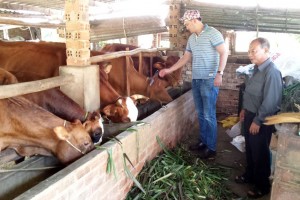Tagline: Livestock waste - Is it really a waste?
Champion: Aziz
Team:
 There is no efficient and adequate animal waste treatment in Vietnam, which leads to increasing environmental issues associated with the productive process. Most of the waste from intensive farming systems have become externalities for farmers as well as to the rest of society. It is known that animal waste produces methane gas, which is 25 times more harmful to the environment than carbon dioxide. According to some sources 78.500 million tons of animal waste is generated per year in Vietnam and quite a significant portion is dumped into the environment. A technology that contributes to better management of methane emissions from animal waste is the use of biogas. Biogas technology brings not only ecological but also economic and social benefits. In recent years, rising energy and fertilizer prices, and incentives for renewable energy production have increased the value of outputs from livestock waste-to-energy systems.
There is no efficient and adequate animal waste treatment in Vietnam, which leads to increasing environmental issues associated with the productive process. Most of the waste from intensive farming systems have become externalities for farmers as well as to the rest of society. It is known that animal waste produces methane gas, which is 25 times more harmful to the environment than carbon dioxide. According to some sources 78.500 million tons of animal waste is generated per year in Vietnam and quite a significant portion is dumped into the environment. A technology that contributes to better management of methane emissions from animal waste is the use of biogas. Biogas technology brings not only ecological but also economic and social benefits. In recent years, rising energy and fertilizer prices, and incentives for renewable energy production have increased the value of outputs from livestock waste-to-energy systems.
A biogas plant is easy to set up, even in smallholder farming systems, because it does not require much investment. A biogas plant stores the livestock manure in a brick dome-shaped tank and precludes the harmful methane gases from going into the atmosphere as the waste undergoes chemical decomposition. Instead, the methane gas is harvested to provide energy for lightening and cooking in the home. A small-scale farmer with only a few animals (about five pigs or two cows) can readily set up a biogas plant.
The primary objective of this research is to study environmental impact of intensive livestock production systems and how the use of biodigesters (and consequently biogas generation) could be a viable option in waste treatment and management. It is clear that there is a need to conduct research (for development) that provides evidence for better utilization of readily available renewable energy source to be fully tapped which can bring immense benefits to farmers and to society as a whole. Considering ILRI's experience in this area and taking into account demand for such research within country, this work has a great potential for collaborative work within ILRI programs.




 There is no efficient and adequate animal waste treatment in Vietnam, which leads to increasing environmental issues associated with the productive process. Most of the waste from intensive farming systems have become externalities for farmers as well as to the rest of society. It is known that animal waste produces methane gas, which is 25 times more harmful to the environment than carbon dioxide. According to some sources 78.500 million tons of animal waste is generated per year in Vietnam and quite a significant portion is dumped into the environment. A technology that contributes to better management of methane emissions from animal waste is the use of biogas. Biogas technology brings not only ecological but also economic and social benefits. In recent years, rising energy and fertilizer prices, and incentives for renewable energy production have increased the value of outputs from livestock waste-to-energy systems.
There is no efficient and adequate animal waste treatment in Vietnam, which leads to increasing environmental issues associated with the productive process. Most of the waste from intensive farming systems have become externalities for farmers as well as to the rest of society. It is known that animal waste produces methane gas, which is 25 times more harmful to the environment than carbon dioxide. According to some sources 78.500 million tons of animal waste is generated per year in Vietnam and quite a significant portion is dumped into the environment. A technology that contributes to better management of methane emissions from animal waste is the use of biogas. Biogas technology brings not only ecological but also economic and social benefits. In recent years, rising energy and fertilizer prices, and incentives for renewable energy production have increased the value of outputs from livestock waste-to-energy systems.
10 Comments